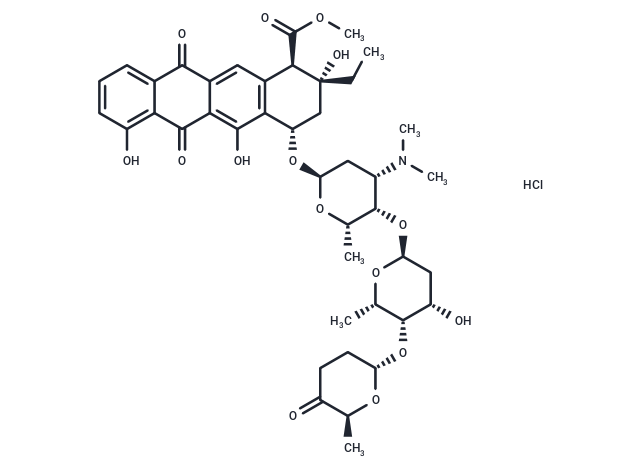Shopping Cart
Remove All Your shopping cart is currently empty
Your shopping cart is currently empty
Aclacinomycin A hydrochloride (Aclarubicin HCl) is an anthracycline antibiotic and inhibitor of topoisomerase I/II, interfering with DNA transcription and replication, inhibiting tumour invasion and angiogenesis, generating reactive oxygen species (ROS), and inhibiting the catalytic centre of the 20S proteasome. It is indicated for the treatment of relapsed leukaemia and advanced malignant lymphoma.

| Pack Size | Price | USA Warehouse | Global Warehouse | Quantity |
|---|---|---|---|---|
| 1 mg | $453 | - | In Stock |
| Description | Aclacinomycin A hydrochloride (Aclarubicin HCl) is an anthracycline antibiotic and inhibitor of topoisomerase I/II, interfering with DNA transcription and replication, inhibiting tumour invasion and angiogenesis, generating reactive oxygen species (ROS), and inhibiting the catalytic centre of the 20S proteasome. It is indicated for the treatment of relapsed leukaemia and advanced malignant lymphoma. |
| In vitro | Method: A cell viability assay was performed using V79 and irs-2 cell lines. Cells were treated with varying concentrations of Aclacinomycin A hydrochloride at 0, 0.006, 0.12, 1.2, and 2.4 μM for 3 hours. The effect on the catalytic activity of topoisomerase II (topo II) was evaluated. Result: Aclacinomycin A hydrochloride significantly inhibited topo II catalytic activity in a dose-dependent manner. Compared to the untreated group, all treated groups showed a statistically significant decrease in topo II activity, indicating that the drug effectively interferes with topo II function and subsequently affects cell viability. [2] |
| In vivo | Method: P-388 leukemia cells were transplanted into DBA/2 and CDF1 (BALB/c × DBA/2) mice. Starting 3 hours after transplantation, mice received daily intraperitoneal injections of Aclacinomycin A hydrochloride for 10 consecutive days at doses of 0.75, 1.5, 3, and 6 mg/kg. Result: Aclacinomycin A hydrochloride significantly inhibited tumor growth in a dose-dependent manner.[3] |
| Animal Research | Animal Model: DBA/2, CDF1 (BALB/c×DBA/2) mice with Leukemia P-388. Dosage: 0.75 mg/kg, 1.5 mg/kg, 3 mg/kg, 6 mg/kg. Administration: Intraperitoneal administration daily for 10 days starting 3 hr after transplantation. Result: Inhibited tumor growth [4]. |
| Synonyms | Aclarubicin hydrochloride |
| Molecular Weight | 848.33 |
| Formula | C42H54ClNO15 |
| Cas No. | 75443-99-1 |
| Smiles | C(OC)(=O)[C@@H]1C2=C([C@@H](O[C@H]3C[C@H](N(C)C)[C@H](O[C@H]4C[C@H](O)[C@H](O[C@@H]5O[C@@H](C)C(=O)CC5)[C@H](C)O4)[C@H](C)O3)C[C@@]1(CC)O)C(O)=C6C(=C2)C(=O)C=7C(C6=O)=C(O)C=CC7.Cl |
| Relative Density. | no data available |
| Storage | Powder: -20°C for 3 years | In solvent: -80°C for 1 year | Shipping with blue ice/Shipping at ambient temperature. | |||||||||||||||||||||||||||||||||||
| Solubility Information | DMSO: 120 mg/mL (141.45 mM), Sonication is recommended. | |||||||||||||||||||||||||||||||||||
| In Vivo Formulation | 10% DMSO+40% PEG300+5% Tween 80+45% Saline: 4 mg/mL (4.72 mM), Sonication is recommended. Please add the solvents sequentially, clarifying the solution as much as possible before adding the next one. Dissolve by heating and/or sonication if necessary. Working solution is recommended to be prepared and used immediately. The formulation provided above is for reference purposes only. In vivo formulations may vary and should be modified based on specific experimental conditions. | |||||||||||||||||||||||||||||||||||
Solution Preparation Table | ||||||||||||||||||||||||||||||||||||
DMSO
| ||||||||||||||||||||||||||||||||||||
| Size | Quantity | Unit Price | Amount | Operation |
|---|

Copyright © 2015-2025 TargetMol Chemicals Inc. All Rights Reserved.